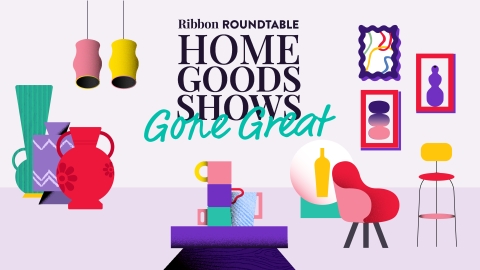Making Home Goods Great: How Trade Shows Should Adapt

Exclusively Sponsored by Ribbon
Home goods is one of the strongest B2B markets in the trade show industry, but how can these shows continue to innovate in a post pandemic landscape? How do they center local manufacture, event tech and true sustainability? Similar to “The Future of Market Centers” and “Launching at Trade Shows Differently”, we gathered the experts to ask the big questions.
Ribbon’s Co-Founder and CEO Vinit Patil moderated a group of home goods veterans including:
- London Design Fair Founder and Ribbon’s Global Fairs Liaison Director, Jimmy MacDonald
- Sales Manager of Milano Home, Esther Boil
- Co-Founder of Hangai Mountain Textiles, Betina Moreira Infante
- President of Alliance Media Strategies, Robert Weissman
Please find highlights below and watch the full roundtable here.
Are Shows on the Rebound?
Right off the bat, our panelists were happy to report that home goods shows weren’t going anywhere, with Betina Moreira Infante happily noting that her recent performance at August’s Shoppe Object was her best yet: “We did Shoppe Object in New York City this August, and honestly, it was our best show. We've been at the show for probably two and a half years now. The February show was slow and I tend to think this is all related to the US economy. There were the recession discussions and regional banks not really lending so much [making it challenging] for retailers to stock inventory. But then for August, we saw a real uptick. So we're really positive about this next season coming up, and hopefully next year as well. So that was really positive. Also we're really looking forward to Shoppe High Point.” Hangai Mountain Textile’s success as a top vendor at Shoppe Object made them an obvious choice for the show’s recent expansion to High Point Market, which just wrapped on October 17th.
Robert Weissman also chimed in that at the end of the day, buyers love the trade show experience: “I think the good news in the big picture is that buyers like to go to shows, I think that's been proven. Certainly during COVID, the virtual sort of fizzled out again, but overall, throughout the industry, the rebound has been incredible.” Robert was also keen to note that home goods shows look especially viable: “The good news is that shows like this [have buyers] actually replenishing inventory. It's not a marketing show. It's not a mind share show, like looking at fixtures or the tools of the trade. It's what I called earlier B2B2C and so much of that is dependent on supply and demand. They're certainly not going to buy if there's no demand. Luckily, there is demand.”
Smaller Shows Are In
Esther Boil described the feedback she received from past editions of Milano Home and how it informed decisions the trade show made: “We realized that the buyer needs to be close to the producers and the manufacturer. They asked us to find products made by craftsmen, [products that have] quality and sustainability.” She also added that it’s important for the trade show experience to feel personal: “You have to keep it small to keep it human… [smaller shows are] more sustainable. [We tell exhibitors] to come with a small booth… we tell them to come with your novelties, come with what makes a difference, because you're here to communicate who you are, what your values are, and what you can do for the market.”
Robert Weissman mirrored many of Esther’s sentiments, saying that organizers and exhibitors need to: “Get away from measuring attendance and miles of aisles. Stop playing the numbers game: 40 million people attended, so on and so forth. 30 million people will walk around in circles in some shows, you know, but who’s really buying? There was so much talk about that, and I think we had the opportunity post COVID to get away from that. Now we're jumping right back into it, but I’m hopeful that it's not just about the number of people, but the buying power they represent and the number of organizations they represent.”
Many of our panelists’ sentiments on the success of smaller, more curated shows were echoed by Jonathan Plotzker-Kelly, Owner and Founder of Heliotrope, during our recent roundtable, “What Exhibitors Really Want”.

How Technology Plays a Role
For Betina, technology is central to the success of a trade show: “When it comes to technology, [the goal is to increase] accessibility and communication, right? I mean, for me, technology can either make or break the show… But it has to be easy to use, easy to adopt. And the thing I appreciate most: the technology can grow with the [trade show] experience.” Betina went on to describe her perfect recipe for event tech, which includes e-commerce with easy API integration as well as lead generation so her team can track down all the busy buyers who didn’t have time to order on the spot. Finally she advocated for AI discovering sales in new places: “Is there a way to better matchmake using AI? Can I find the designers that are working on boutique hotels? What’s the [easiest way to gather] that information, is it even there?”
Robert used his expert tech background to fill in the gaps on AI’s potential for data collection, noting that while clunky questionnaires often miss the mark, “You could use AI to create a web crawler or have somebody do it for you. Someone who can tell you about who's attending the show, just by looking at their LinkedIn profile or corporate website. There’s far more information there than what you're going to get on a traditional questionnaire.”
A Renewed Focusing on Storytelling
Esther described how Milano Home is utilizing the incredible space of Fiera Milano to create unique experiences buyers will remember: “[We’ll have] an area called ‘Vibes’ dedicated to textiles and fragrances, where the people will be able to touch the textile… to feel [different fabrics] like cashmere and wool and build education on these products and materials.” She went on to talk about the importance of storytelling and how education around brands and products builds the personal and human touch we’re craving.
As an exhibitor, Betina resonated with this approach: “What sells our product is our story. We have a very personal story. We don't try to sell 10,000 throws, we’re trying to make sure that we have really solid partnerships. That the business has a lot of purpose and soul to what we're doing. We're really invested in our partners in Mongolia. So being able to do that is what sets us apart.”
To watch the full roundtable, please visit Ribbon’s YouTube channel. For more information on Ribbon, please visit their website


Add new comment